- Home
- Ron Chernow
Titan Page 4
Titan Read online
Page 4
John D. Rockefeller, right, at age thirteen, with brother William, eleven, and sister Mary Ann, nine. (Courtesy of the Rockefeller Archive Center)
CHAPTER 2
Fires of Revival
When the Rockefellers moved thirty miles north from Richford to Moravia, they progressed from a backward, frontier settlement to a more sedate community with neat frame houses in the town center. Settled by the United Brethren in Christ—an evangelical denomination that later merged with the United Methodist Church—Moravia was already a stronghold of temperance and antislavery sentiment and boasted a hotel, general store, cotton mill, and Congregational church. Even today, Moravia is a quaintly authentic piece of Americana, with graceful, shady streets that have a companionable feel and houses with wide, friendly verandas.
The Rockefellers lived on the rural outskirts north of town. Around 1843, Bill put down a thousand dollars for a ninety-two-acre parcel of grassy upland that gently sloped down to Owasco Lake, one of the most picturesque of the Finger Lakes. He enlarged an existing house until it contained seven or eight rooms favored with superb views, framed by tall pines, of the bright blue lake set against a backdrop of wooded hills on the far shore. Barns stood across the road, and a smokehouse out back enabled the family to cure ham and bacon. For John D., this two-story clapboard house was a scene of enchantment and became his enduring emblem of pastoral beauty. In the summertime, he loved to pull yellow perch from the cold, clear lake, and even winters captivated him in spite of the bitter cold. The Rockefeller children slept in an unplastered upstairs room that was heated only by a stovepipe rising from the kitchen; snow flurries and sharp winter squalls pressed through cracks in the walls. “How the wind used to roar among the hemlocks by the shore of the lake!” Rockefeller remembered dreamily in his late seventies.1 In the predawn dark, the children were often awakened by the sharp chopping of woodcutters or the squeal of sleds on hard-packed snow. Eliza would stand at the foot of the stairs and call up to her eldest son, “Come, my son; time to get up and milk your cow!”2 To warm his feet in the dim, cold barn, John always stood on the steaming earth just vacated by the cow he was milking.
The first three Rockefeller children—Lucy, John, and William—had been born in Richford. Now, in 1843, with Big Bill again on the road during months of her pregnancy, Eliza gave birth to a second daughter, Mary Ann; two years later, twins arrived. The boy, Frank, was healthy, but Frances was sickly from birth and received some seventy visits from a local doctor before she died just short of her second birthday. Eliza tried to protect the seven-year-old John D. from this first lacerating brush with death, but it remained engraved on his memory. When he visited Moravia as an old man in his eighties, he pointed to a field and explained that “when Frances was buried I was sent over to that field to pick stones, so that I should not know.”3 He later exhibited an unacknowledged dread of death, and Eliza was perhaps the first to intuit it.
In Moravia, William Avery Rockefeller acted like a strange amalgam of solid citizen and engaging ne’er-do-well. As in Richford, the townsfolk goggled as he sped by on swift horses, decked out in smart clothes, and his prodigal spending sometimes fostered the impression that he was the town’s richest man. Mary Ann later dismissed the “ridiculous” stories of their childhood poverty. “We always had plenty to eat and wear, and every reasonable kind of comfort. We were not rich, of course—far from it; but we had enough to eat and use and save—always.”4 Moravia was the golden period of John’s boyhood when his father briefly aspired to gentility. One neighbor even labeled Bill “about the most notable man in the community.”5 Since the region was rich in pristine pine forests, he organized a legitimate and quite successful logging business. Before dawn, guided only by starlight and lanterns, he and his work gangs carted logs to the lakeside by bobsled, then floated them up to Auburn, situated at the lake’s northern tip. In a sudden burst of civic spirit, Bill helped to select the site for the town school by counting the revolutions of his buggy wheels as he drove through town, then placing the school at the exact middle of the community; he persuaded local taxpayers to pay for it at a time when many people still thought families should educate their children at home. With the resourceful, go-getter attitude later transmitted to his son, Bill also stocked Owasco Lake with pickerel and even headed the local temperance committee. “That’s the kind of man he was,” boasted John D. “He’d get a thing done while his neighbors were beginning to talk about it.”6 The Moravia period revealed an important truth about Bill: He had an underlying craving for respectability and probably didn’t plan to spend his whole life as a floating charlatan, preying on the gullible.
Bill never deigned to dirty his hands with farmwork, of course, which he considered beneath his dignity. He hired a railroad worker named Hiram Odell to work the farm and look after his family during his still-frequent wanderings. As Bill instructed him, “Their mother ain’t strong enough to manage ’em and they need some managing. Do just what you think is right for ’em.”7 While Odell cultivated the garden in his spare time, Eliza assigned chores to the children. Drawing a string across the garden one day, she told the two oldest boys, “John, you take care of this side of the string, and, Will, this side is yours.”8 In contrast to his father’s disdain for manual labor, John—always a self-styled son of the common people—gloried in the rigors of country life, which, he came to believe, toughened him for later industrial struggle. His frugal boyhood hardened an already stoic nature and made him proof against later adversity.
There was enough economic activity in the America of the 1840s to stimulate the fancy of any future mogul. Banks sprang up everywhere, canals crosshatched the countryside, steamboats plied the rivers, railroads and telegraphs welded together the first national markets. Territorial expansion was in the air: Texas was annexed in 1845, and war with Mexico seemed inevitable. Though only dimly aware of such distant developments, John D. Rockefeller already seemed a perfect specimen of homo economicus. Even as a boy, he bought candy by the pound, divided it into small portions, then sold it at a tidy profit to his siblings. By age seven, encouraged by his mother, he was dropping gold, silver, and copper coins that he earned into a blue china bowl on the mantel. John’s first business coup came at age seven when he shadowed a turkey hen as it waddled off into the woods, raided its nest, and raised the chicks for sale. To spur his enterprise, Eliza gave him milk curds to feed the turkeys, and the next year he raised an even larger brood. As an old man, Rockefeller said, “To this day, I enjoy the sight of a flock of turkeys, and never miss an opportunity of studying them.” 9
Despite Rockefeller’s roseate memories, early photos of him tell a much more somber tale. His face was grim, expressionless, lacking boyish joy and animation; the skin is drawn, the eyes blank and devoid of luster. To other people, he often seemed abstracted, and they remembered him with a deadpan face trudging along country roads, lost in thought, as if unraveling deep problems. “He was a quiet boy,” said one Moravia resident. “He seemed always to be thinking.”10 In many respects, John was forgettable and indistinguishable from many other boys. When he later dazzled the world, many former neighbors and classmates struggled to summon up even a fuzzy image of him. He was a slow learner but patient and persistent and, like J. P. Morgan and Jay Gould, exhibited a terrific head for math. “I was not an easy student, and I had to apply myself diligently to prepare my lessons,” said Rockefeller, who described himself accurately as “reliable” but not “brilliant.”11 For thirty weeks per year (rural children needed time off for farm chores), he attended the one-room schoolhouse established by his father, a spare white building with a pitched roof and windows adorned with dark shutters. Discipline was harsh and exacting: When students misbehaved, the teacher menacingly held a slate over their heads. If Rockefeller didn’t excel in class, it might have been in part because he lacked the bright boy’s exhibitionism, the yearning for gold stars; always inner-directed and indifferent to the approval of others, he was therefore free of a c
ertain boyish vanity.
With the benefit of hindsight, we can see that there was something extraordinary about the way this stolid boy pinpointed goals and doggedly pursued them without any trace of childish impulsiveness. When playing checkers or chess, he showed exceptional caution, studying each move at length, working out every possible countermove in his head. “I’ll move just as soon as I get it figured out,” he told opponents who tried to rush him. “You don’t think I’m playing to get beaten, do you?”12 To ensure that he won, he submitted to games only where he could dictate the rules. Despite his slow, ponderous style, once he had thoroughly mulled over his plan of action, he had the power of quick decision.
Although he was generally grave and devoted much time to books, music, and church, he had a sly wit, the sort that curled up unexpectedly around the edges of a sentence. As his sister-in-law said, “He had a quick sense of humor, though one might say he was soberly mirthful. His appreciation was keen, but I do not recall him as ever laughing loudly. But I do remember the quick lighting up of his eyes, and the dimples that showed in his cheek when he heard or saw anything amusing.”13 His sister Mary Ann remembered him as an inveterate tease. “He would plague us all with his jokes, always with a straight, solemn face.”14 Rockefeller always had a droll sense of fun, but it was often obscured behind a mask of gravity.
John D. Rockefeller was drawn to the church, not as some nagging duty or obligation but as something deeply refreshing to the soul. The Baptist church of his boyhood provides many clues to the secrets of his character. As a young man, he was raised on a steady diet of maxims, grounded in evangelical Protestantism, that guided his conduct. Many of his puritanical attitudes, which may seem antiquated to a later generation, were merely the religious commonplaces of his boyhood. Indeed, the saga of his monumental business feats is inseparable from the fire-and-brimstone atmosphere that engulfed upstate New York in his childhood. Even his father, wont to flirt with the devil’s company, knew many hymns by heart and urged his children to go to church; he once offered John five dollars to read the Bible cover to cover, thus creating an early, unintentional association between God and money. Always an iconoclastic, outlaw spirit, Bill never actually joined a church—that would have been going too far—so John identified religion with his beloved mother, who found in the Bible a balm for her troubled spirit.
John attended a Sunday school a short distance from their hilltop house and remembered the teacher as a formerly profane man who had repented and become an earnest Christian. The boy saw religion less as a system of otherworldly rewards than as a means for moral reformation on earth. Since Bill was often away, Eliza coaxed a Presbyterian neighbor into dropping off her and the children at the Baptist church on Sunday mornings. As the family huddled together in a pew, Eliza encouraged the children to drop pennies into the collection plate; Rockefeller later cited his mother’s altruism as the genesis of his philanthropy. Early in life, he learned that God wanted his flock to earn money and then donate money in a never-ending process. “I was trained from the beginning to work and to save,” Rockefeller explained. “I have always regarded it as a religious duty to get all I could honorably and to give all I could. I was taught that way by the minister when I was a boy.”15 The low-church Baptists didn’t prohibit the accumulation of wealth but did oppose its vain, ostentatious display, setting up a tension that would be threaded throughout Rockefeller’s life.
While the first Baptist church had been founded by Roger Williams in Rhode Island in 1639, the denomination didn’t flourish until the so-called Great Awakening that began around 1739. This upsurge of religious fervor gathered force following the tour of the eastern seaboard by the charismatic English Methodist evangelist George Whitefield. In open fields, amid much weeping, shrieking, fainting, and guilty writhing on the ground, masses of people were converted to Christianity or had their sagging faith restored. This period of rabid emotion spurred fantastic growth among Baptists, who believed in voluntary immersion and a public confession of faith from adherents. More than one hundred new Baptist churches sprang up in New England alone. With their lay leaders and autonomous congregations, the Baptists were ideally suited to frontier areas and the democratic ethos of the colonists. Recruited from the common people, often unpaid and poorly educated, Baptist ministers ventured into the hinterlands where other clergymen feared to tread. Because they opposed religious establishments and owed no allegiance to supervisory bishops or a central church hierarchy, they could start up a church in any creek or hollow. They emerged as a major religious force by the close of the eighteenth century.
A Second Great Awakening aroused New England and the mid-Atlantic states to a new pitch of religious fever from 1800 to the late 1830s. This protracted movement peaked around 1830, when the revival fires blazed so hotly that Rochester and other sections of upstate New York and Ohio were dubbed the Burned-Over District. When revivalists—of whom Charles Grandison Finney was the most celebrated—arrived in a town, they held prayer meetings that often lasted through the night. These theatrical spectacles, marked by dramatic outpourings of emotion, featured hardened sinners who sat on the “anxious bench” as townspeople publicly urged them to repent. When they saw the light, the guilty parties often burst into tears and knelt in prayer. Preachers tried to reach people through vivid appeals to hope and fear, invoking heavenly bliss and burning lakes of hellfire. One popular evangelist, Jacob Knapp, described tormented sinners crawling up the sides of burning pits while devils with pitchforks, perched on the rim, sadistically prodded them back down into the flames. The revival movement was self-perpetuating, for the saved were expected to rescue others from Satan’s clutches. They would go door-to-door, trying to flush sinners from their homes until the entire town was caught up in passionate, hysterical emotion.
Several aspects of this revival movement are worth noting because they are so strikingly reflected in Rockefeller’s life. In the late 1820s, militant evangelicals in Rochester agitated against smoking, dancing, card playing, billiards, and the theater, while boycotting stores that opened on the Sabbath. As Rockefeller said, “Going back . . . to my early business days and boyhood, the Baptists I knew listened to their consciences and their religious instructions, not only did not dance in public places but did not dance anywhere and did not even concede the reputability of dancing. . . . The theater was considered a source of depravity, to be shunned by conscientious Christians.”16 Because liquor was considered a satanic brew, a believer couldn’t make it, sell it, or offer it to guests, and a temperance pledge became a standard component of accepting Christ into one’s life. In his boyhood, Rockefeller internalized an abiding sense that the professing Christian had to be a soldier armed against all secular temptation and must never stray far from godly circles.
Departing from strict Calvinism, Baptist evangelicals clung to the egalitarian view that all errant souls could be saved, not just a small, predestined elect, and they actively engaged in evangelism and missionary work. Rockefeller was brought up to believe that nobody was ever irretrievably lost, that people were free agents who could be redeemed by an act of will—a self-reliant outlook that stamped his conservative political views. His Baptist upbringing also predisposed him to follow the cult of perpetual self-improvement that played so prominent a role in nineteenth-century American culture. Finney, for instance, was a Presbyterian who exhorted his listeners to pursue perfection in their earthly lives.
Rockefeller entered the Baptist Church at a fateful moment. In May 1845, in a schism over the issue of slaveholders serving as missionaries, Baptist delegates from nine southern states seceded from the national body to create the Southern Baptist Convention. Northern Baptists fervently believed that abolitionism was consistent with their opposition to ecclesiastical hierarchy, their populist spirit, and their broad-based campaign to purge sin from society. The Second Great Awakening had explicitly linked personal conversion with community reform, spawning political activism. During the colonial period, Am
ericans had liberally consumed demon rum, but the new evangelical emphasis on social uplift helped to foster a national temperance movement in the 1820s and 1830s. For Rockefeller, an apolitical man, the church narrowed his social life but widened his vision, providing a bridge to larger social concerns and ultimately preparing him for the world of philanthropy.
If John D. believed, despite the flamboyant antics of Devil Bill, that he had enjoyed a homespun boyhood out of a Currier & Ives print, it was largely due to the compensating influence of Eliza and the church. Her hardships tapped some deep reserve of strength and wisdom in the simple country woman with the spare face, quiet ways, and steady blue-gray eyes. “Mother was wonderful,” said Mary Ann. “She managed the family and the house and did it all so easily.”17 Though Eliza dutifully read the Bible, her few surviving missives reveal an extremely rudimentary education; she misspelled the most elementary words, writing herd for heard, plesant for pleasant, and ben for been. (John was a faultless speller and grammarian.) All but a stranger to grammar, she sometimes wrote letters that consisted of a single run-on sentence.

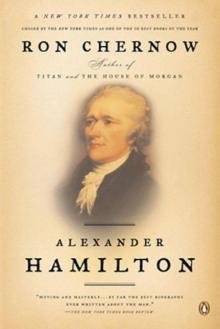 Alexander Hamilton
Alexander Hamilton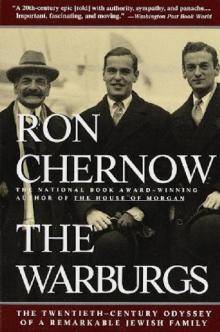 The Warburgs
The Warburgs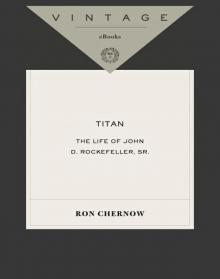 Titan
Titan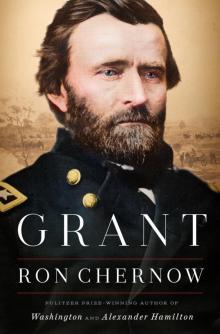 Grant
Grant Washington
Washington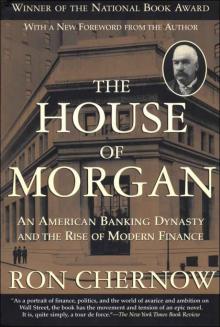 The House of Morgan
The House of Morgan The House of Morgan: An American Banking Dynasty and the Rise of Modern Finance
The House of Morgan: An American Banking Dynasty and the Rise of Modern Finance